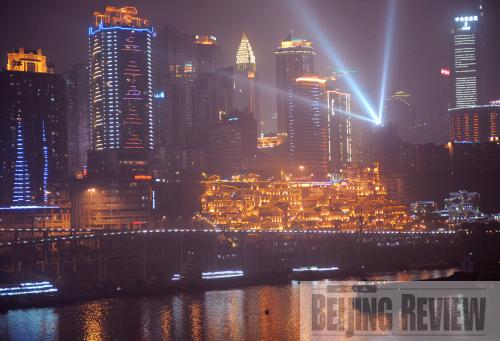|
 |
|
GROWING CITY: Chongqing has undergone dramatic changes in its appearance since it became a municipality directly under the Central Government on June 18, 1997 (ZHOU HENGYI) |
Thousands of cargo ships are busy loading and unloading goods in front of Chaotianmen Square Dock, where the Yangtze and Jialingjiang rivers meet. It is a scene of thriving business.
In 2008, Chongqing Municipality achieved 14.3 percent GDP growth. The region yielded 12.6 percent growth from January to June of this year, and is set to see an estimated 14 percent GDP increase for the whole year.
"Though we're still faced with many difficulties, Chongqing's economy has pulled itself through a mild winter and a warm spring, and has come into the height of summer," said Yang Qingyu, Director of the Development and Reform Commission of Chongqing.
Standing up
Chongqing, despite its insulated location in China and less dependence on export, was no safe haven against the global financial crisis and could not escape from being affected as a longtime heavily industrial city. Industrial giants Chongqing Iron and Steel Group and Chongqing Machinery and Electronics Group, both state-owned enterprises (SOE) with more than 10 billion yuan ($1.47 billion) of yearly sales revenue, have seen their operating revenues and profits plunge.
Motorcycle exports nosedived to 93,000 per month in February, the lowest single month of sales since February 2006. "The first quarter of this year has been the most difficult for Chongqing's industrial and economic development than any other time in the past 10 years," said Wu Bing, Director of Chongqing Economic and Information Technology Commission.
Shortly after the Spring Festival, the Chinese lunar new year that fell on January 26, the speed of the fall slowed in the added value of Chongqing's large-scale enterprises, and growth returned in the ensuing months. In January, the figure decreased by 3.7 percent compared with the same period last year, and increased by 6 percent in February, followed by 8.8 percent growth in March, 11.2 percent in April, 12.3 percent in May and 13.7 percent in June.
On December 31, 2008, an executive meeting of the State Council was held to launch measures to spur coordinated urban and rural reform and development in Chongqing. Soon after, the General Office of the State Council issued a document including 13 important plans designed for Chongqing, such as creating a modern manufacturing base in the municipality, turning it into financial center of the upper reaches of the Yangtze River, a comprehensive transportation hub, an inland export commodities processing base and a pilot opening region.
According to Huang Qifan, Executive Vice Mayor, the Central Government's macroeconomic policies such as the 4 trillion yuan ($586 billion) stimulus package and the 10 major industrial adjustment and revitalization plans have worked exceptionally well, and each of the measures fuels Chongqing's economy.
So far, more than 7 billion yuan ($1.02 billion) of national investment has been put in Chongqing, which has been met by new investment worth 50 billion yuan ($7.35 billion) from other sectors. Eight out of the 10 major revitalized industries can be found in Chongqing.
The economy's rapid rebound is also attributed to precautions put in place in Chongqing before the crisis and a vigorous response once the trouble started.
In March 2008, Chongqing issued seven measures to stimulate economic growth after a fact-finding trip to the coastal areas of Guangdong, Shanghai and Zhejiang. In September, officials introduced five policies to thwart economic decline and in November, they unveiled a three-year investment plan worth 1.5 trillion yuan ($220 billion). In December, the municipality also adopted 12 special measures to stimulate economic growth.
| 